|
On
Saturday 9 August 2008, at the campus of National Graduate Institute
for Policy Studies (GRIPS), we held the Fourth VDF-Tokyo Conference
on the Development of Vietnam. The same as other annual conferences
held since 2005, this conference also aimed to disseminate research
findings and policy implications for Vietnamfs development, as well
as expand human networking for research on Vietnam.
In
this conference, we welcomed about 50 participants from different
research and policy-making institutions and universities in Japan
and other countries. The conference included six presentations, in
which there were two keynote presentations in the morning session,
and four paper presentations in the afternoon. These presentations
covered different topics on the current status and future challenges
of Vietnamfs development.
The
conference was officially opened by a welcoming speech from Mr.
Giang Thanh Long, a VDF-Tokyo research fellow. He also reviewed the
research activities of both VDF offices in Hanoi and Tokyo since its
establishment.
@
MORNING
SESSION: KEYNOTE PRESENTATIONS
@
Keynote
Speaker 1: Professor Kenichi Ohno
"Industrial
Strategy for Vietnamfs New Era: Policy Content and Formulation
Method"
Professor Kenichi
Ohno, VDF research director, delivered the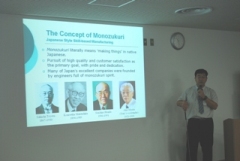 first keynote presentation in the morning session. The main theme of
his presentation was about industrial strategies for Vietnam in the
new era of development. According to him, high economic growth in
Vietnam would help the country reach to the middle-income country
group in very near future. In order to promote such a strategy, a
breakthrough in productivity and production value is necessary. In
addition to this core objective, Vietnam also needed to create
internal source of growth, deal with new social problems arisen from
urbanization and high economic growth, and improve macroeconomic
management capacity. Going further with industrial development as
the main motive for the countryfs growth and development, Prof. Ohno
argued that the industrial base in Vietnam has been weak with simple
manufacturing production under imported technology. Vietnam needed
to promote the ecatching-upf process by learning good and bad
experiences from neighboring countries, particularly Malaysia and
Thailand. These two countries experienced impressive
industrialization processes under large flows of foreign direct
investment and supportive policies from their governments. Though,
these two countries also had failures, which have been mainly
attributed to their heavy dependence on foreign factors, and
production has not really been internalized. As such, two countries
in particular and ASEAN in general have not been able to overcome
the eglass ceilingf to achieve a higher level of production as those
of Korea and Taiwan. For Vietnam, under swift economic
transformation and integration as well as influential globalization,
Prof. Ohno suggested a production cooperation with Japan in order to
improve Vietnamfs competitiveness. Such a cooperation resulted from
such important factors as ongoing demographic changes toward aging
society in Japan, and lack of skilful industrial human resources in
Vietnam. Among a variety of policies pursuing such a strategy, Prof.
Ohno argued that supporting industries would play a crucial role. To
promote these industries, he proposed a list of epolicy menu and
actionsf, which included such activities as industrial capacity
building, industrial human resources development, financial
promotion, foreign investment marketing. More importantly, Prof.
Ohno also emphasized that the current policy formulation in Vietnam
needed to be fundamentally reformed, so as to further promote
industrial development in particular, and economic growth and
development in general in the coming decades.
first keynote presentation in the morning session. The main theme of
his presentation was about industrial strategies for Vietnam in the
new era of development. According to him, high economic growth in
Vietnam would help the country reach to the middle-income country
group in very near future. In order to promote such a strategy, a
breakthrough in productivity and production value is necessary. In
addition to this core objective, Vietnam also needed to create
internal source of growth, deal with new social problems arisen from
urbanization and high economic growth, and improve macroeconomic
management capacity. Going further with industrial development as
the main motive for the countryfs growth and development, Prof. Ohno
argued that the industrial base in Vietnam has been weak with simple
manufacturing production under imported technology. Vietnam needed
to promote the ecatching-upf process by learning good and bad
experiences from neighboring countries, particularly Malaysia and
Thailand. These two countries experienced impressive
industrialization processes under large flows of foreign direct
investment and supportive policies from their governments. Though,
these two countries also had failures, which have been mainly
attributed to their heavy dependence on foreign factors, and
production has not really been internalized. As such, two countries
in particular and ASEAN in general have not been able to overcome
the eglass ceilingf to achieve a higher level of production as those
of Korea and Taiwan. For Vietnam, under swift economic
transformation and integration as well as influential globalization,
Prof. Ohno suggested a production cooperation with Japan in order to
improve Vietnamfs competitiveness. Such a cooperation resulted from
such important factors as ongoing demographic changes toward aging
society in Japan, and lack of skilful industrial human resources in
Vietnam. Among a variety of policies pursuing such a strategy, Prof.
Ohno argued that supporting industries would play a crucial role. To
promote these industries, he proposed a list of epolicy menu and
actionsf, which included such activities as industrial capacity
building, industrial human resources development, financial
promotion, foreign investment marketing. More importantly, Prof.
Ohno also emphasized that the current policy formulation in Vietnam
needed to be fundamentally reformed, so as to further promote
industrial development in particular, and economic growth and
development in general in the coming decades.
Keynote Speaker 2: Mr. Noritaka Akamatsu
"Finance and
Enterprise Sector Reform in Vietnam"
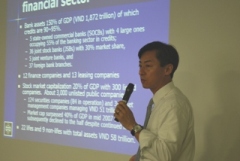 The
second keynote speech was delivered by Mr. Noritaka Akamatsu. He is
the lead financial economist of the World Bank in Vietnam, and a
capital market advisor for Asia and the Pacific Region. In his
presentation, Mr. Akamatsu focused on the recent development and
challenges of the financial and enterprise sector, particularly
banking system, in Vietnam. The statistical data showed that the
financial sector in Vietnam has been impressively growing in both
quantitative and qualitative aspects in a short period. The banking
sector has also rapidly grown in order to meet the growing financial
demand. According to Mr. Akamatsu, however, such a swift growth
under insufficient institutional and legal frameworks has resulted
in a variety of financial market fluctuations and challenges. For
instance, only a small part of rural areas could be able to access
banking services, slow process of equitization and huge
non-performing loans for the state-owned enterprises, uncertain
monetary market, and lack of good human resources for managing these
important sectors. In addition, Mr. Akamatsu also analyzed the
underlying factors of the macroeconomic turbulences in Vietnam since
early 2008, including accelerating inflation and trade account
deficit. Such important factors included global inflation,
aggressive public sector investment in infrastructure, huge inflows
of remittances and foreign direct investment, and the pegging of
Vietnamese Dong to US Dollar. Regarding policy implications, Mr.
Akamatsu suggest Vietnam have more active financial and monetary
policies, in order to promote growth and development of all economic
sectors. More importantly, he emphasized that there has been no
signal for a financial crisis in Vietnam, and timely and appropriate
macroeconomic policies were essential and important. In the short
term, inflows of foreign direct investment would have powerful
impacts on the economy, and thus consistent and timely policies
toward these flow would be requested. In the longer term, Vietnam
should strengthen exports and promote import-substitution. Moreover,
the domestic long-term savings should be mobilized with
institutional investors and contractual savings. Bond market would
become a crucial power in the financial market in the coming years. The
second keynote speech was delivered by Mr. Noritaka Akamatsu. He is
the lead financial economist of the World Bank in Vietnam, and a
capital market advisor for Asia and the Pacific Region. In his
presentation, Mr. Akamatsu focused on the recent development and
challenges of the financial and enterprise sector, particularly
banking system, in Vietnam. The statistical data showed that the
financial sector in Vietnam has been impressively growing in both
quantitative and qualitative aspects in a short period. The banking
sector has also rapidly grown in order to meet the growing financial
demand. According to Mr. Akamatsu, however, such a swift growth
under insufficient institutional and legal frameworks has resulted
in a variety of financial market fluctuations and challenges. For
instance, only a small part of rural areas could be able to access
banking services, slow process of equitization and huge
non-performing loans for the state-owned enterprises, uncertain
monetary market, and lack of good human resources for managing these
important sectors. In addition, Mr. Akamatsu also analyzed the
underlying factors of the macroeconomic turbulences in Vietnam since
early 2008, including accelerating inflation and trade account
deficit. Such important factors included global inflation,
aggressive public sector investment in infrastructure, huge inflows
of remittances and foreign direct investment, and the pegging of
Vietnamese Dong to US Dollar. Regarding policy implications, Mr.
Akamatsu suggest Vietnam have more active financial and monetary
policies, in order to promote growth and development of all economic
sectors. More importantly, he emphasized that there has been no
signal for a financial crisis in Vietnam, and timely and appropriate
macroeconomic policies were essential and important. In the short
term, inflows of foreign direct investment would have powerful
impacts on the economy, and thus consistent and timely policies
toward these flow would be requested. In the longer term, Vietnam
should strengthen exports and promote import-substitution. Moreover,
the domestic long-term savings should be mobilized with
institutional investors and contractual savings. Bond market would
become a crucial power in the financial market in the coming years.
@
AFTERNOON SESSION: PAPER PRESENTATIONS
Presentation 1: Assistant Professor Katsushi Imai
"Poverty,
Inequality, and Ethnic Minorities in Vietnam"
The first
presentation of the afternoon session was from Dr. Katsushi Imai, an
assistant professor at the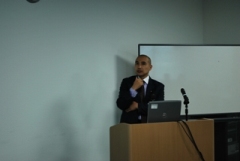 Department of Economics, the University of Manchester. Using the
data from the Vietnam Household Living Standard Surveys (VHLSS) in
2002 and 2004, his paper aimed to determine the underlying factors
of poverty for the ethnic minorities in Vietnam, and explain why
these people have been persistently poorer than Kinh and Chinese
people. In the paper, Dr. Imai used logit models and decomposition
techniques to identify determinants of poverty incidence of the
interested groups. The estimated results showed that the ethic
minorities have experienced chronic poverty, but also were much
poorer than were Kinh and Chinese people. As such, they have been
vulnerable to various shocks, particularly income shock.
Decomposition analysis also pointed out that the ethnic minorities
had numerous disadvantages in comparison with Kinh and Chinese
people, such as very low literate rates and low average income. The
finding also indicated that even the ethnic minorities had the same
endowments as did Kinh and Chinese, it would still be difficult for
them to get out of poverty. In other words, substantial structural
differences between regions have been a critical factor leading to
poverty and inequality between ethnic minorities and eethnic
majoritiesf (Kinh and Chinese), in which the former have been facing
a number of disadvantages. From such findings, Dr. Imai suggested
that Vietnamese government invest more in infrastructure and promote
non-farm activities for disadvantageous areas where many ethnic
minorities are living.
Department of Economics, the University of Manchester. Using the
data from the Vietnam Household Living Standard Surveys (VHLSS) in
2002 and 2004, his paper aimed to determine the underlying factors
of poverty for the ethnic minorities in Vietnam, and explain why
these people have been persistently poorer than Kinh and Chinese
people. In the paper, Dr. Imai used logit models and decomposition
techniques to identify determinants of poverty incidence of the
interested groups. The estimated results showed that the ethic
minorities have experienced chronic poverty, but also were much
poorer than were Kinh and Chinese people. As such, they have been
vulnerable to various shocks, particularly income shock.
Decomposition analysis also pointed out that the ethnic minorities
had numerous disadvantages in comparison with Kinh and Chinese
people, such as very low literate rates and low average income. The
finding also indicated that even the ethnic minorities had the same
endowments as did Kinh and Chinese, it would still be difficult for
them to get out of poverty. In other words, substantial structural
differences between regions have been a critical factor leading to
poverty and inequality between ethnic minorities and eethnic
majoritiesf (Kinh and Chinese), in which the former have been facing
a number of disadvantages. From such findings, Dr. Imai suggested
that Vietnamese government invest more in infrastructure and promote
non-farm activities for disadvantageous areas where many ethnic
minorities are living.
Presentation 2: Associate Professor Wade D. Pfau
"Demographic
Changes and the Pension Finances in Vietnam: A Long-term Stochastic
Actuarial Assessment"
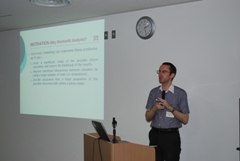 Discussing
another issue of the social security system, Dr. Wade D. Pfau, an
associate professor of GRIPS, shared his findings on the long-term
pension finance for Vietnam. This has been one of the concerned
issues for the social insurance scheme in Vietnam, as population
aging was expected and millions of people have participated in the
scheme. In this paper, Dr. Pfau applied stochastic simulation
techniques, which have been applied recently to the pension fund
projections in some developed economies. This method allows
estimating the pension fund balance within a confidence interval. As
such, it mitigated a variety of drawbacks from the previous
scenario-based projections for the Vietnamese pension fund. The
estimated results indicated that the status-quo pension fund would
be depleted in 2052 with a 90-percent confidence interval of 8
years, meaning that the pension fund will be deficit in 2049 at the
earliest, and 2057 at the latest. Sensitivity tests showed that
contribution rates, indexation of benefits, and actual retirement
ages would be significant factors in determining the long-term
balance of the pension fund. Conversely, coverage rates,
administrative costs, and rate of returns on investments would not
help to significantly improve the fund. From these findings, Dr.
Pfau argued that Vietnam did not need to reform the current
pay-as-you-go (PAYG) defined-benefits scheme to a system of
individual accounts as suggested for other countries. Instead,
Vietnam should conduct partial reforms with emphasis on such
important factors as indexation of benefits, reduction of
contribution avoidance and early retirement. Another important
factor was that Vietnam should diversify the pension asset
allocations, so that the real rate of returns on investment could be
higher. In the long-term when Vietnamese population would be aging,
wise investment strategy would be a core factor to maintain the
pension fund. Discussing
another issue of the social security system, Dr. Wade D. Pfau, an
associate professor of GRIPS, shared his findings on the long-term
pension finance for Vietnam. This has been one of the concerned
issues for the social insurance scheme in Vietnam, as population
aging was expected and millions of people have participated in the
scheme. In this paper, Dr. Pfau applied stochastic simulation
techniques, which have been applied recently to the pension fund
projections in some developed economies. This method allows
estimating the pension fund balance within a confidence interval. As
such, it mitigated a variety of drawbacks from the previous
scenario-based projections for the Vietnamese pension fund. The
estimated results indicated that the status-quo pension fund would
be depleted in 2052 with a 90-percent confidence interval of 8
years, meaning that the pension fund will be deficit in 2049 at the
earliest, and 2057 at the latest. Sensitivity tests showed that
contribution rates, indexation of benefits, and actual retirement
ages would be significant factors in determining the long-term
balance of the pension fund. Conversely, coverage rates,
administrative costs, and rate of returns on investments would not
help to significantly improve the fund. From these findings, Dr.
Pfau argued that Vietnam did not need to reform the current
pay-as-you-go (PAYG) defined-benefits scheme to a system of
individual accounts as suggested for other countries. Instead,
Vietnam should conduct partial reforms with emphasis on such
important factors as indexation of benefits, reduction of
contribution avoidance and early retirement. Another important
factor was that Vietnam should diversify the pension asset
allocations, so that the real rate of returns on investment could be
higher. In the long-term when Vietnamese population would be aging,
wise investment strategy would be a core factor to maintain the
pension fund.
Presentation 3: Mr. Nguyen Trong Ha
"The Economics
of Not Using Health Insurance Card: A Case Study of Vietnam"
After 20-minute
coffee break with lively exchange of information, the conference
continued with a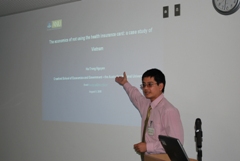 presentation from Mr. Nguyen Trong Ha, a lecturer of the National
Economics University (NEU) in Hanoi, and a PhD candidate at the
Australian National University (ANU). His research aimed to answer
the question of why people did not use their health insurance card
when accessing health care services. To pursue such an interesting
and important question, Mr. Ha used the data from the Vietnam
Household Living Standards Survey in 2006 (namely, VHLSS 2006). The
statistical data showed that there were 14 percent of the health
insurance scheme participants did not use their cards, and this was
due to cumbersome procedures, low-quality services, or health
insurance was not reimbursed at the health facilities. In order to
evaluate such a situation in a greater detail, Mr. Ha used the
number of times going to health facilities for both inpatient and
outpatient treatments as a proxy for the use of health care
services. This indicator was then compared between different groups
categorized by individual and household characteristics. The
estimates implied that income, health status, treatment costs, costs
for accessing health facilities, waiting time at health facilities,
and quality of treatments were significant factors in determining
the use of health care services with health insurance cards. An
impressive point was that the percentage of poor and ill people who
could access health care services has increased, particularly in
comparison with rich and healthy people. However, the paper also
showed that lack of information and low reliability of health care
services have made a number of people out of their eligible
services. With these findings, Mr. Ha suggested that the expansion
of the health insurance be on voluntary bases, and improvement of
health care services using health insurance cards need to be
addressed. Without such efforts, policy objective to provide
universal health insurance for Vietnamese people would never be
reached.
presentation from Mr. Nguyen Trong Ha, a lecturer of the National
Economics University (NEU) in Hanoi, and a PhD candidate at the
Australian National University (ANU). His research aimed to answer
the question of why people did not use their health insurance card
when accessing health care services. To pursue such an interesting
and important question, Mr. Ha used the data from the Vietnam
Household Living Standards Survey in 2006 (namely, VHLSS 2006). The
statistical data showed that there were 14 percent of the health
insurance scheme participants did not use their cards, and this was
due to cumbersome procedures, low-quality services, or health
insurance was not reimbursed at the health facilities. In order to
evaluate such a situation in a greater detail, Mr. Ha used the
number of times going to health facilities for both inpatient and
outpatient treatments as a proxy for the use of health care
services. This indicator was then compared between different groups
categorized by individual and household characteristics. The
estimates implied that income, health status, treatment costs, costs
for accessing health facilities, waiting time at health facilities,
and quality of treatments were significant factors in determining
the use of health care services with health insurance cards. An
impressive point was that the percentage of poor and ill people who
could access health care services has increased, particularly in
comparison with rich and healthy people. However, the paper also
showed that lack of information and low reliability of health care
services have made a number of people out of their eligible
services. With these findings, Mr. Ha suggested that the expansion
of the health insurance be on voluntary bases, and improvement of
health care services using health insurance cards need to be
addressed. Without such efforts, policy objective to provide
universal health insurance for Vietnamese people would never be
reached.
Presentation 4: Dr. Le Viet Trung
"The
Revolution of Vietnamese Distribution System"
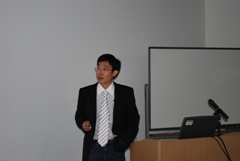 The
last presenter of the afternoon session was Dr. Le Viet Trung, a
post-doctoral research fellow of Kobe University, Japan. His
research analyzed the revolutionary changes of the Vietnamese
distribution system, and identified the underlying factors of such
changes. An overview of the distribution system in Vietnam showed
that economic policies from Doi moi (renovation) has
significantly contributed to its changes. Along with high economic
growth, the number of distribution channels, particularly at
household level, and revenues have increased substantially in the
period 1991-2002. In order to see such swift changes, Dr. Trung
provided an analysis of the data from a survey that he conducted in
Hanoi. In comparison with another survey implemented in 1997 by
other researchers, Dr. Trungfs survey data showed that Vietnamese
consumersf preferences and demands have evolved, in which they had
really different perception and decision about prices, quality of
services, and quality of products. As such, the main question was
what factors led to these significant changes? Dr. Trung tried to
identify possible factors using four hypotheses on income, quality
and safety of products, prices, and convenience in accessing
markets. Applying probit models, Dr. Trung compared the decision to
buy fresh food, processed food and drinks, and non-food products
using different individual characteristics of interviewed consumers
(e.g. age, gender, and income) and other characteristics (e.g.
convenience and transport). The estimated results indicated that
prices, convenience, quick bargain, and freshness were important
factors for fresh food in the traditional markets, while food
security, income, and transport were crucial for this food in super
markets. A striking finding was that gender, age, and quality of
services did not have significant impacts on decision of consumers
to buy fresh food. For processed food and drinks, and non-food
product, prices were extremely important factor. Dr. Trung argued
that traditional markets and super markets were both ecompetitorsf
and ecoordinatorsf in the Vietnamese distribution system because
they had advantages and drawbacks to consumers, who had various
preferences and demands. As such, policies to promote the
development of different distribution channels so as to guarantee
healthy competition would play important role in expanding and
diversifying distribution system in meeting peoplefs demand. The
last presenter of the afternoon session was Dr. Le Viet Trung, a
post-doctoral research fellow of Kobe University, Japan. His
research analyzed the revolutionary changes of the Vietnamese
distribution system, and identified the underlying factors of such
changes. An overview of the distribution system in Vietnam showed
that economic policies from Doi moi (renovation) has
significantly contributed to its changes. Along with high economic
growth, the number of distribution channels, particularly at
household level, and revenues have increased substantially in the
period 1991-2002. In order to see such swift changes, Dr. Trung
provided an analysis of the data from a survey that he conducted in
Hanoi. In comparison with another survey implemented in 1997 by
other researchers, Dr. Trungfs survey data showed that Vietnamese
consumersf preferences and demands have evolved, in which they had
really different perception and decision about prices, quality of
services, and quality of products. As such, the main question was
what factors led to these significant changes? Dr. Trung tried to
identify possible factors using four hypotheses on income, quality
and safety of products, prices, and convenience in accessing
markets. Applying probit models, Dr. Trung compared the decision to
buy fresh food, processed food and drinks, and non-food products
using different individual characteristics of interviewed consumers
(e.g. age, gender, and income) and other characteristics (e.g.
convenience and transport). The estimated results indicated that
prices, convenience, quick bargain, and freshness were important
factors for fresh food in the traditional markets, while food
security, income, and transport were crucial for this food in super
markets. A striking finding was that gender, age, and quality of
services did not have significant impacts on decision of consumers
to buy fresh food. For processed food and drinks, and non-food
product, prices were extremely important factor. Dr. Trung argued
that traditional markets and super markets were both ecompetitorsf
and ecoordinatorsf in the Vietnamese distribution system because
they had advantages and drawbacks to consumers, who had various
preferences and demands. As such, policies to promote the
development of different distribution channels so as to guarantee
healthy competition would play important role in expanding and
diversifying distribution system in meeting peoplefs demand.
TOP
Photos
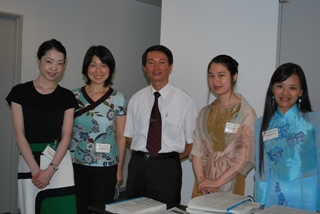 |
 |
|
Welcome to our
conference |
Keynote
Presenters |
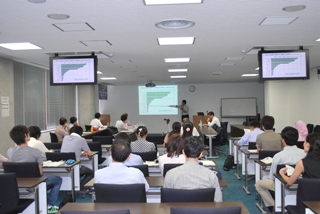 |
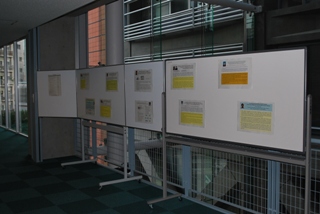 |
|
Participants |
One Page
Presentation |
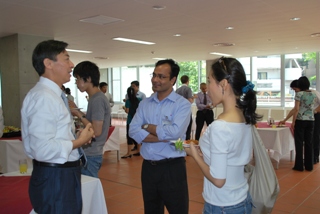 |
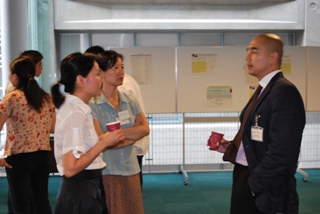 |
|
Networking
during the lunch time |
Networking
during the break time |
|
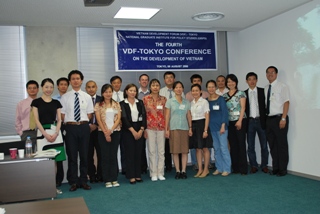 |
|
Presenters and
participants.... |
TOP |